Looking back on humanity’s achievements, you can pinpoint certain landmark moments that changed the world forever. One such moment was, undoubtedly, the birth of the automobile which, like rail transport before it and aviation afterward, completely revolutionized how humans moved around.
Many people deserve credit for this achievement. As you are about to find out, the concept of the “first car in the world” is, by no means, a settled matter, but the lion’s share of the accolades goes to Karl Benz who designed and built what is regarded by many as the true first automobile.
They say that behind every great man, there is a great woman and, perhaps, there is no better example than Bertha Benz. She was there to support her husband through thick and thin, enjoying the highs together and using her own money to get him back on his feet during the lows. Then, of course, there was also her iconic road trip which solidified the car as a practical machine.
Bertha’s daringness combined with Karl’s engineering genius ensured that people finally looked at the car as something that could actually be used in day-to-day life. We’ve come a long way since then, but it would be completely fair to say that the automotive industry would not be what it is today without Karl Benz.
Early Years
Karl Benz, sometimes spelled with a C instead of a K, was born Karl Friedrich Vaillant on November 25, 1844, in the German town of Mühlburg which today is a borough of Karlsruhe in the state of Baden-Württemberg. His name was Vaillant because his father, Johann Georg Benz, and his mother, Josephine Vaillant, were not married at the time of his birth. However, they did, in fact, marry a few months later and the baby became Karl Friedrich Benz.
Johann Benz was a locomotive driver, but he died in an accident when Karl was only two years old. This left the family in dire financial straits, but the mother did her best to ensure a good education for her son.
Young Karl followed in his father’s footsteps and studied engineering and, from an early age, proved to be a prodigious student. In fact, when he was just 19 years old, Karl Benz graduated with a degree in mechanical engineering from the University of Karlsruhe.
This was in 1864 and yet, it would be a while before Benz finally found his vocation in life. He spent the next seven years trying out various jobs with multiple construction and engineering firms throughout Germany, but he found them all to be unsatisfying. At the same time, he became an avid bicycle rider and enjoyed tinkering with them, fantasizing about a similar vehicle that would be motorized.

In 1871, Karl Benz started his first business. He partnered with a mechanic named August Ritter and opened the Iron Foundry and Mechanical Workshop in Mannheim. The company was not successful and, within a year, it was struggling financially. Fortunately for Benz, he soon found a better partner, one who would have an enormous impact on his life and the development of the automobile – his bride-to-be, Bertha Ringer.
Karl and Bertha
Bertha Ringer had been born in a time when it was firmly believed that women had no business with scientific and mechanical matters and that even just exerting their brains would decrease their ability to have children. Certainly not the case here – Karl and Bertha would go on to have five children together. And yet, even when she was young, Bertha took an interest in engineering. According to a particularly heartbreaking legend, she became determined to show the world that women were capable of achieving great things after reading her family’s Bible one day and finding an entry that said “Unfortunately only a girl again” – written by her father, on the day she was born.
Whether this story is true or not, the elder Mr. Ringer did leave Bertha a substantial dowry after working as a successful carpenter all his life. Besides her wealth, Bertha Ringer was also a beautiful and clearly intelligent woman. When she reached marrying age, she had a long list of potential suitors to choose from. And yet, fate led to a poor, disheveled engineer named Karl Benz to share the same coach as Bertha and her mother during an excursion in 1869. The two started talking and, as soon as Karl brought up a horseless carriage he was working on, he captured Bertha’s interest and, soon enough, her heart. Despite warnings and admonishments from her family, Bertha’s mind was made up – Karl was the man she wanted to be with for the rest of her life.
The couple married in 1872. Bertha’s support of her husband was unwavering. Her first act was to use part of her dowry to buy out August Ritter’s share in Benz’s company. The rest of her money was used to keep the business afloat while Karl worked on new patents. Although Benz was, undoubtedly, a genius engineer and designer, nobody could ever accuse him of being a shrewd businessman.
The Benz Companies
Benz’s first great achievement was his stationary gasoline two-stroke engine. He was inspired by the work of an earlier German engineer, Nikolaus Otto, who created the first four-stroke engine in 1861. Benz received a patent for his invention in 1880 and went on to add improvements such as an engine speed regulation system and ignition via a battery system.
This new device of Benz managed to garner interest from banks and businessmen who wanted to invest. Because he needed the capital to grow his company, Benz converted his business into a joint-stock company named Gasmotoren-Fabrik Mannheim in 1882. This did not work out as he hoped it would. After all the agreements were completed, Benz ended up only owning five percent of the company. More importantly, he did not have a say in how the business was run, anymore. Not a significant one, at least. His partners had differing notions on what products to design and sell and the engineer’s ideas often went ignored. Not happy with this arrangement, Karl Benz left the corporation the following year.
Undeterred, Benz looked to start a new company but, this time, he searched for more amenable partners. He found them in Max Rose and Friedrich Wilhelm Esslinger, two men who owned a bicycle repair shop in Mannheim. Together, they established the Benz & Companie Rheinische Gasmotoren-Fabrik, better known simply as Benz & Co. The business focused on manufacturing engines and proved to be profitable, growing to 25 employees in a short amount of time. This newfound success eased the pressure off Benz a little bit and allowed him to indulge in his passion project – building an automobile using his engine.
The First Car?
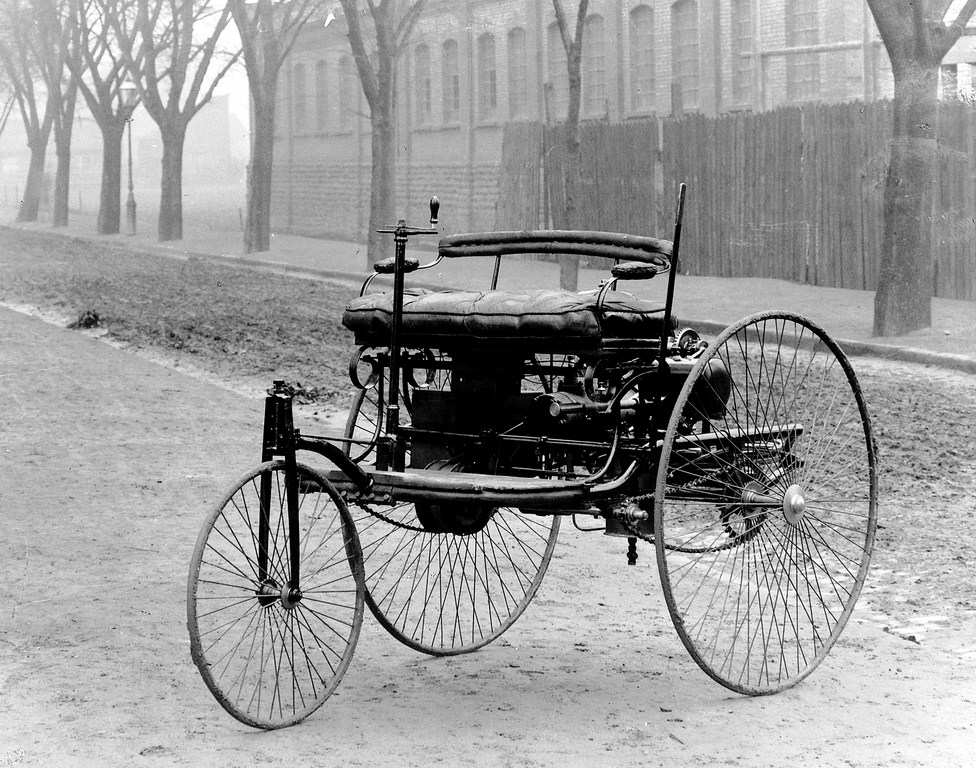
In 1885, Karl Benz finished his magnum opus – the Benz Patent Motorwagen. It was a two-seater vehicle. It had three wire-spoke wheels and a single-cylinder, gasoline-powered engine that formed a single unit with the chassis and was capable of producing 0.75 horsepower and reaching top speeds of 10 mph. Other bells and whistles on the vehicle included a controlled exhaust valve, an automatic intake slide, and high-voltage electrical vibrator ignition with spark plug. In January of 1886, Benz received patent number 37435 for his “vehicle powered by a gas engine” or the “birth certificate of the automobile”, as it came to be known. Later in July, Benz drove his car in public for the first time.
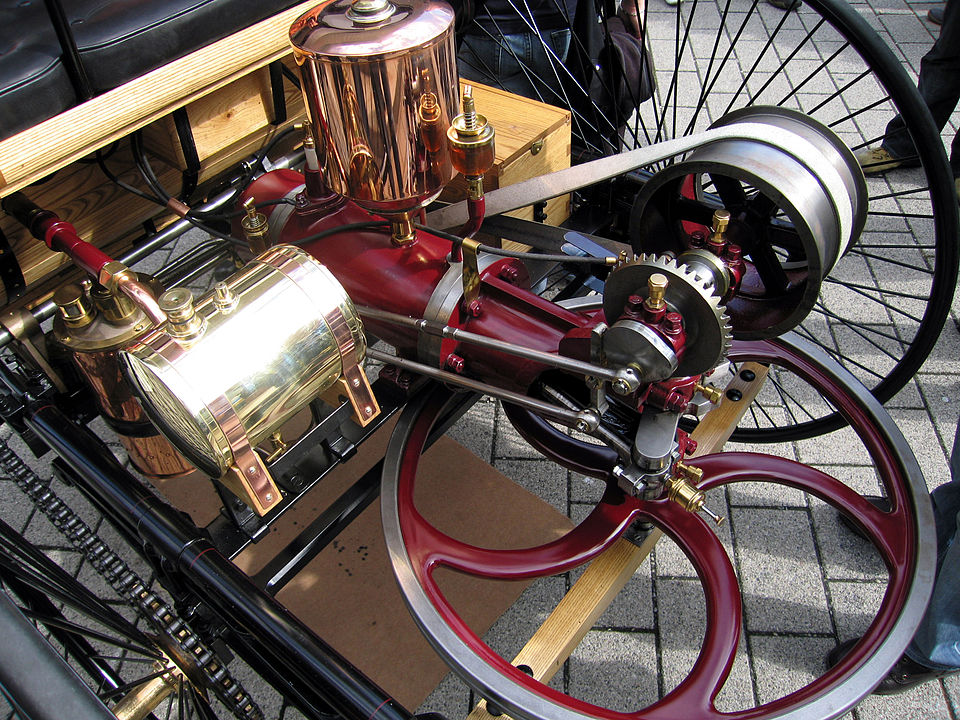
So was this the first car in the world? Well, for the sake of simplicity, it is generally regarded as the first automobile, but that question is difficult to answer because it depends on what your definition of an “automobile” is. The Motorwagen definitely does not look like our idea of a “car” today, but it was the first vehicle of its kind to be made commercially available to the public. Benz’s machine had another advantage over designs that came before it in that it managed to function without exploding or falling apart while in operation.
The truth is that some people regard an automobile as simply a self-propelled vehicle powered by some kind of engine and, in that case, we have to go even farther back than horseless carriages. French inventor Nicolas-Joseph Cugnot created a full-size mechanical land vehicle called the Fardier à vapeur back in 1769. It weighed over 8,800 lbs and was powered by steam.
In 1807, another Frenchman named Isaac de Rivaz designed an experimental vehicle powered by hydrogen gas. Robert Anderson was a Scottish inventor who created an electric carriage sometime during the 1830s which was powered by non-rechargeable batteries.
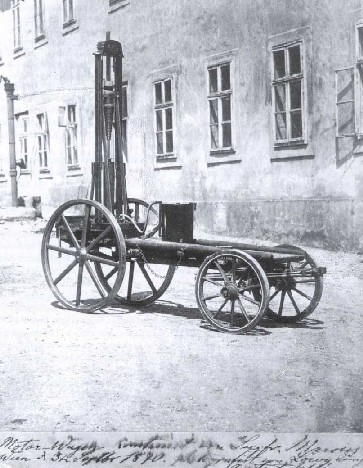
In 1867, Belgian Jean-Joseph-Etienne Lenoir built a vehicle powered by an atmospheric gas engine. German Siegfried Marcus did something similar a few years later by combining a handcart with an atmospheric engine. He did keep improving his design and ended up with something that could be called a car, but this happened in 1888, after the Benz Patent Motorwagen.
We should also mention the French team of Édouard Delamare-Deboutteville and his assistant Leon Malandin who started work on a vehicle with an internal combustion engine and a three-wheeled chassis back in 1883. Some people do argue that Delamare-Deboutteville might deserve some of the accolades usually given to Karl Benz, but the truth of the matter is that his vehicle never functioned well enough to go into production.
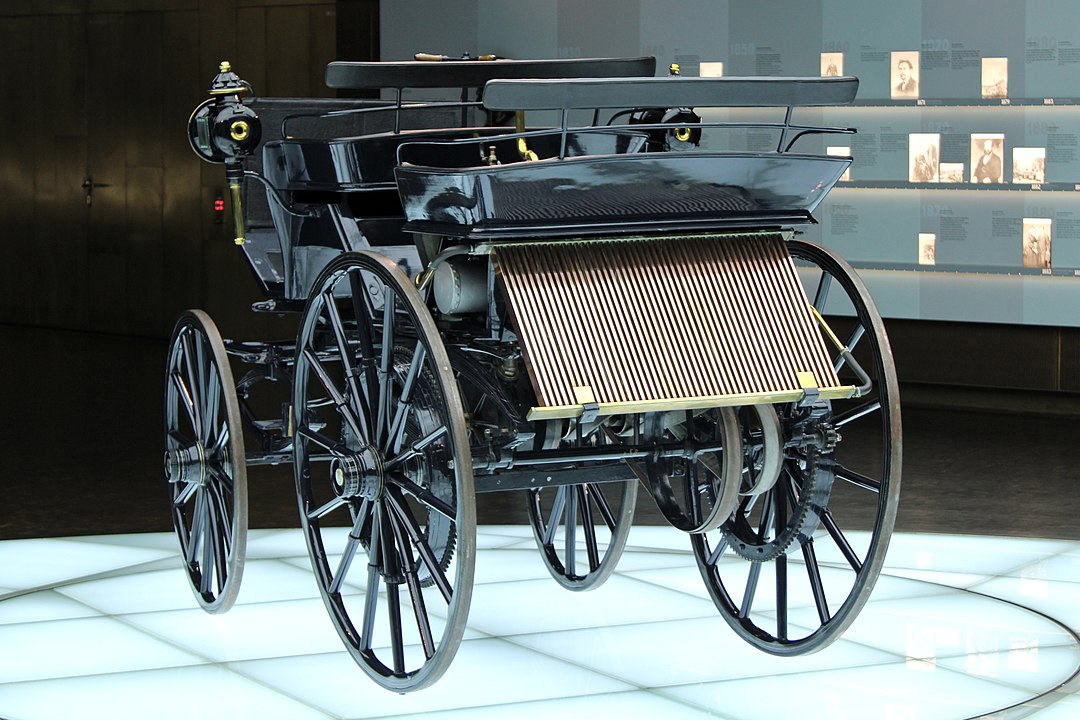
Last, but not least, we should also include Gottlieb Daimler and Wilhelm Maybach who were working on their own automobile independently of Karl Benz, at the same time, about 60 miles away. They finished the Daimler Motorcoach a couple of months after the Benz Motorwagen.
As you can see, the question of “Who built the first car?” is a tricky one and does not have a universal answer, although we can generally agree that the Benz Patent Motorwagen was the first practical automobile and, therefore, set in motion the nascent stages of an industry that would grow to become one of the biggest in the world.
The Trip that Changed Everything
After the original Motorwagen came out, Benz immediately went back to work. Two new and improved models of his automobile were released in the next couple of years. But it seemed like the rest of the world did not share Karl and Bertha’s vision for an automotive future as demand for the Motorwagen was not particularly high. The Benz engine still sold nicely, but what would be the point of buying a whole vehicle? Up until then, these kinds of self-powered machines were only used in trials over short distances and still needed mechanics to be on hand. There was no practicality to them whatsoever. Not to mention the fact that they were expensive and would have only been accessible to the rich elite. They were not interested, though, because they considered something like the Motorwagen to be too loud and messy – not very gentlemanly. What the car needed was a bit of good PR.
Like we said before, Karl Benz was at his best when he was getting his hands dirty in the workshop. Fortunately for him, Bertha had a better mind for marketing and she realized that they needed some kind of stunt not only to garner publicity for their new product but also to show people that it had a purpose. Therefore, in the early hours of a hot August day in 1888, Bertha Benz jumped behind the wheel of a Benz Patent Motorwagen No. 3 and embarked on one of the most important automotive journeys in history – the first long-distance trip by car.
Bertha did not tell her husband of her plan. She also did not inform the authorities so, technically, what she did was illegal. Bertha recruited her teenage sons, Richard and Eugen, to tag along for the ride, and left Mannheim in the morning on the pretense of going to visit her mother in Pforzheim. This was 66 miles away and, while that might sound like a routine trip nowadays, it was significantly longer than any journey that had been previously attempted in any kind of motorized carriage. Moreover, Bertha had to contend with problems that nobody else had to deal with, starting with the fact that there were no roads suitable for cars back then. She had to follow wagon tracks for most of the way and even went on ancient Roman roads in some parts.
Another problem was fuel as the Motorwagen needed to refuel every 15 to 20 miles and, obviously, there were no gas stations anywhere. Her automobile used a fuel called ligroin which was a petroleum-based solvent that could be bought at pharmacies. Bertha made a stop at Wiesloch and paid a visit to the local apothecary, looking to buy ten liters of ligroin. This startled the elderly chemist who saw a young woman with stains on her dress and naturally assumed that she wanted to use the solvent to clean her clothes. He offered her a one-liter bottle, noting that that would be sufficient but Bertha, of course, had no interest in clean clothes. She was looking to refuel her car. In the end, she purchased three liters of ligroin which was all the chemist had in stock but, since then, that pharmacy in Wiesloch has branded itself the first fuel station in the world. It even has a monument of Bertha and her two sons in front of it.
Other problems included needing to refill the water tank regularly, a chain that broke and had to be fixed by a blacksmith, the leather brake pads that wore out and had to be replaced by shoemakers, and even the occasional steep hill where the boys had to get out and push the car. Bertha even showed off her own know-how on occasion, using her garter to plug a leak and hairpins to clear up clogged valves. The 66-mile journey took over 12 hours, but Bertha, Richard, and Eugen made it to Pforzheim safely.
More importantly, the trip achieved its goal. Many people took notice, some were even frightened to the point of prayer by the crazy woman speeding through their towns in a “smoking monster.” Almost overnight, everyone heard of the Benz Patent Motorwagen. And in case they missed her the first time, they had another chance soon after because, a few days later, Bertha and the boys returned home in the same car, but on a different route. Moreover, Bertha even identified a few ways of improving the Benz car, such as adding a new gear for climbing hills.
In 2008, this 121-mile long return trip from Mannheim to Pforzheim was declared a European Route of Industrial Heritage and there is a parade of antique cars that follows it every two years in celebration of Bertha’s iconic voyage.
Finding Success
Bertha’s trip was a turning point for the automobile industry, but especially for the Benz company. Of course, we were still decades away from the car becoming the standard method of transportation, but people started to see it not as some kind of oddity, but the way of the future.
The Benz Patent Motorwagen went on sale in 1888 and, bizarrely, it sold better in France than in Germany. Again, this was down to Karl Benz’s lack of business acumen. Because of this, transactions were slow in his native country. In France, however, the marketing was done by a Parisian engineer and bicycle manufacturer named Emile Roger who had more of a flair for showmanship. Roger was already a successful distributor of Benz engines and he received sole agency rights to sell Benz cars in France. Some of his creative marketing ideas included showing off his Motorwagen Model III at the 1889 World’s Fair and signing up the cars for racing events.
There was some tension between the two because Roger made an effort to minimize Benz’s role in the development of the car and increase his own. He gave out leaflets to prospective buyers that described the automobile, not once mentioning the name “Benz.” He made special Roger badges that he fitted to the cars he sold and he made sure that the vehicles he raced were all referred to as Roger cars.
Even with Roger’s shenanigans, the Benz company continued to grow and had to relocate to a bigger production factory. By 1890, it had become the second-largest engine manufacturer in Germany and was poised to grow even more after the addition of two new partners – Friedrich von Fischer and Julius Ganss.
As for Karl, he cared about the one thing he always cared about – the engineering. Throughout the 1890s, he came up and patented several new innovations, most notably the double-pivot steering, planetary gear transmission, and the flat engine with a boxer configuration which was better known as the contra engine back then.

At the recommendation of his partners, Karl designed a new and improved automobile – the Benz Victoria which went on sale in 1892. However, it was his follow-up design, the Benz Velo, that really took off and came to be regarded as the world’s first large-scale production car. By the end of its sales run in 1902, over 1,200 Velos had been sold. And, while Karl was looking for new ways to use his increasingly-powerful engines, he also invented the motorized bus, originally capable of seating eight people.
Later Years
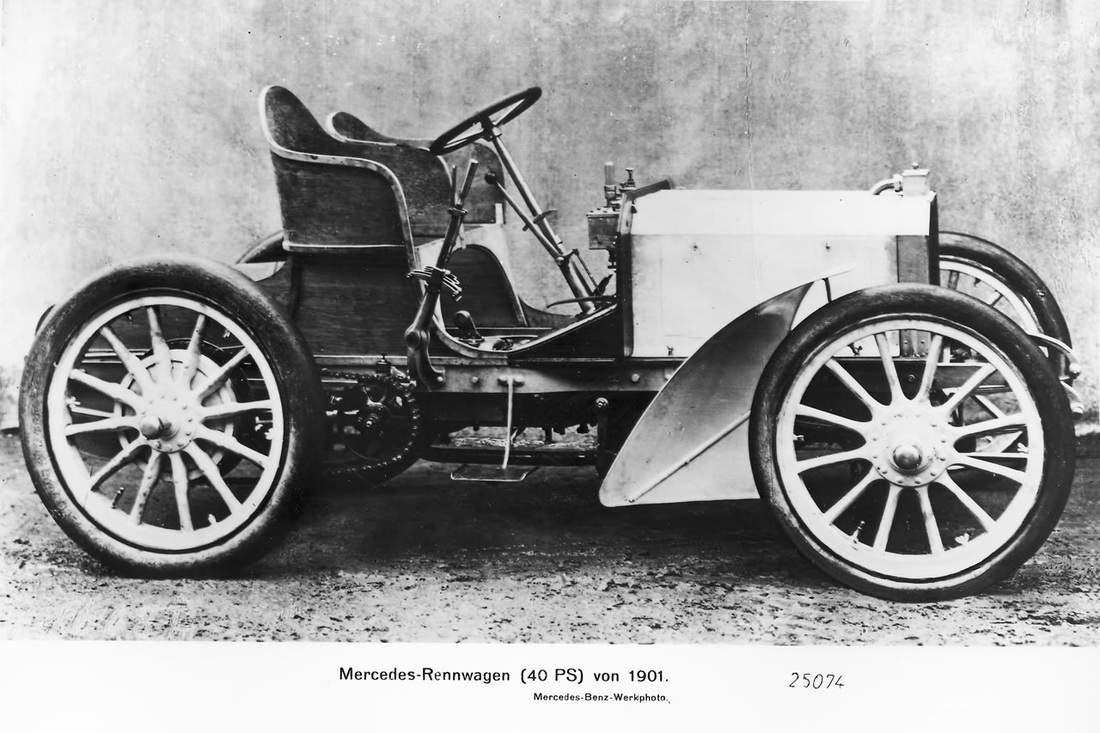
Although Benz & Co was successful, it was feeling the heat from its number one competitor, Daimler Motoren Gesellschaft (DMG) headed by Gottlieb Daimler and Wilhelm Maybach. Daimler passed away in 1900 but, just one year later, Maybach designed and produced his crowning achievement – the Mercedes 35 HP. While previous cars still mostly looked like coaches with engines fitted to them, this was a vehicle we would consider to resemble our modern idea of a car. Not to mention that it was the first automobile branded as a Mercedes.
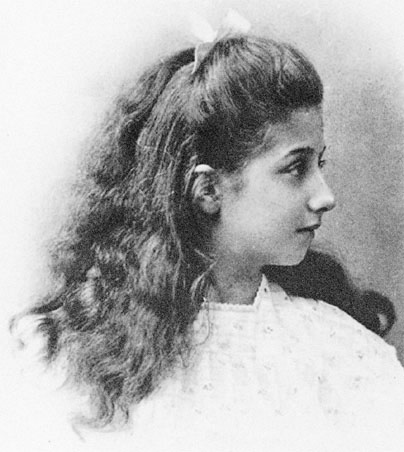
And in case you were wondering where the Mercedes name comes from, it was named after the daughter of Austrian businessman Emil Jellinek who not only commissioned the 35 HP, but was very hands-on in its development and specifically requested certain improvements that ensured the car became a landmark moment in automotive history.
To counter their competition, the Benz company brought in some French designers to help with new models. This angered Karl Benz who resigned his position in 1903, although he still remained on the board of directors. His sons Richard and Eugen soon followed suit and they founded a new company, Carl Benz Söhne, in 1906, headquartered in Ladenburg. They searched for new markets and found success in England where their cars became quite popular as taxis.
Because the Benz family had enough capital by this point, they never issued public stocks in this new company so they could retain complete control over it. Benz Sons lasted until 1923, although Karl Benz liquidated his shares and retired in 1912, leaving the business in the hands of his sons.
During the 1920s, the German economy plummeted and all industries were hurting, including the automotive one. In order to survive, Benz & Co and DMG signed an “Agreement of Mutual Interest” in 1924. The automakers combined their production and marketing efforts while still retaining their individual brands in order to save on costs. This did not last long as just two years later, they merged completely and formed Daimler-Benz. Immediately, this deal was a success as their sales tripled in 1927. All their new vehicles were labeled as Mercedes-Benz, a brand that is still as popular as ever.
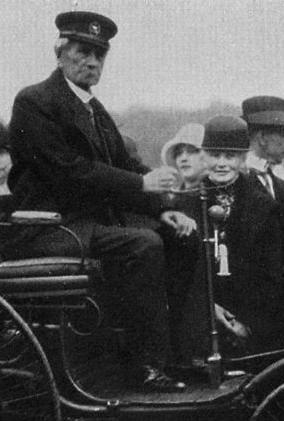
Karl stayed on the board of directors for the rest of his life. He died on April 4, 1929, at the age of 84, in his home in Ladenburg. Bertha kept on living in the same home, until she also passed away on May 5, 1944. They both lived long enough to see the industry that they helped create and dedicated their entire lives to grow and thrive into one which became indispensable to humanity.



